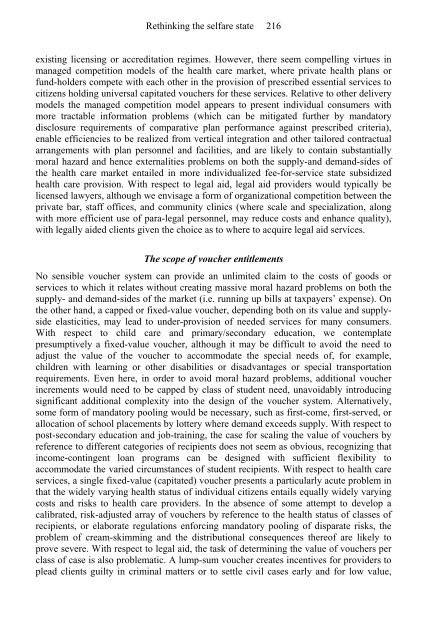Rethinking the Welfare State: The prospects for ... - e-Library
Rethinking the Welfare State: The prospects for ... - e-Library
Rethinking the Welfare State: The prospects for ... - e-Library
Create successful ePaper yourself
Turn your PDF publications into a flip-book with our unique Google optimized e-Paper software.
<strong>Rethinking</strong> <strong>the</strong> selfare state 216<br />
existing licensing or accreditation regimes. However, <strong>the</strong>re seem compelling virtues in<br />
managed competition models of <strong>the</strong> health care market, where private health plans or<br />
fund-holders compete with each o<strong>the</strong>r in <strong>the</strong> provision of prescribed essential services to<br />
citizens holding universal capitated vouchers <strong>for</strong> <strong>the</strong>se services. Relative to o<strong>the</strong>r delivery<br />
models <strong>the</strong> managed competition model appears to present individual consumers with<br />
more tractable in<strong>for</strong>mation problems (which can be mitigated fur<strong>the</strong>r by mandatory<br />
disclosure requirements of comparative plan per<strong>for</strong>mance against prescribed criteria),<br />
enable efficiencies to be realized from vertical integration and o<strong>the</strong>r tailored contractual<br />
arrangements with plan personnel and facilities, and are likely to contain substantially<br />
moral hazard and hence externalities problems on both <strong>the</strong> supply-and demand-sides of<br />
<strong>the</strong> health care market entailed in more individualized fee-<strong>for</strong>-service state subsidized<br />
health care provision. With respect to legal aid, legal aid providers would typically be<br />
licensed lawyers, although we envisage a <strong>for</strong>m of organizational competition between <strong>the</strong><br />
private bar, staff offices, and community clinics (where scale and specialization, along<br />
with more efficient use of para-legal personnel, may reduce costs and enhance quality),<br />
with legally aided clients given <strong>the</strong> choice as to where to acquire legal aid services.<br />
<strong>The</strong> scope of voucher entitlements<br />
No sensible voucher system can provide an unlimited claim to <strong>the</strong> costs of goods or<br />
services to which it relates without creating massive moral hazard problems on both <strong>the</strong><br />
supply- and demand-sides of <strong>the</strong> market (i.e. running up bills at taxpayers’ expense). On<br />
<strong>the</strong> o<strong>the</strong>r hand, a capped or fixed-value voucher, depending both on its value and supplyside<br />
elasticities, may lead to under-provision of needed services <strong>for</strong> many consumers.<br />
With respect to child care and primary/secondary education, we contemplate<br />
presumptively a fixed-value voucher, although it may be difficult to avoid <strong>the</strong> need to<br />
adjust <strong>the</strong> value of <strong>the</strong> voucher to accommodate <strong>the</strong> special needs of, <strong>for</strong> example,<br />
children with learning or o<strong>the</strong>r disabilities or disadvantages or special transportation<br />
requirements. Even here, in order to avoid moral hazard problems, additional voucher<br />
increments would need to be capped by class of student need, unavoidably introducing<br />
significant additional complexity into <strong>the</strong> design of <strong>the</strong> voucher system. Alternatively,<br />
some <strong>for</strong>m of mandatory pooling would be necessary, such as first-come, first-served, or<br />
allocation of school placements by lottery where demand exceeds supply. With respect to<br />
post-secondary education and job-training, <strong>the</strong> case <strong>for</strong> scaling <strong>the</strong> value of vouchers by<br />
reference to different categories of recipients does not seem as obvious, recognizing that<br />
income-contingent loan programs can be designed with sufficient flexibility to<br />
accommodate <strong>the</strong> varied circumstances of student recipients. With respect to health care<br />
services, a single fixed-value (capitated) voucher presents a particularly acute problem in<br />
that <strong>the</strong> widely varying health status of individual citizens entails equally widely varying<br />
costs and risks to health care providers. In <strong>the</strong> absence of some attempt to develop a<br />
calibrated, risk-adjusted array of vouchers by reference to <strong>the</strong> health status of classes of<br />
recipients, or elaborate regulations en<strong>for</strong>cing mandatory pooling of disparate risks, <strong>the</strong><br />
problem of cream-skimming and <strong>the</strong> distributional consequences <strong>the</strong>reof are likely to<br />
prove severe. With respect to legal aid, <strong>the</strong> task of determining <strong>the</strong> value of vouchers per<br />
class of case is also problematic. A lump-sum voucher creates incentives <strong>for</strong> providers to<br />
plead clients guilty in criminal matters or to settle civil cases early and <strong>for</strong> low value,


